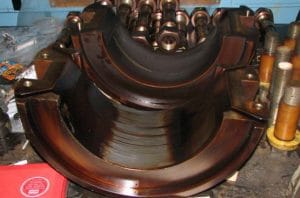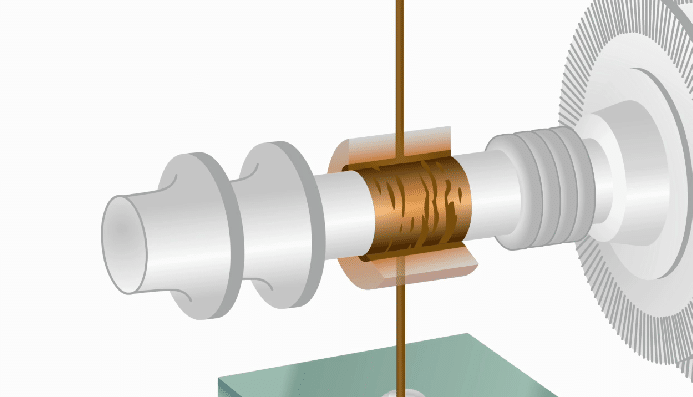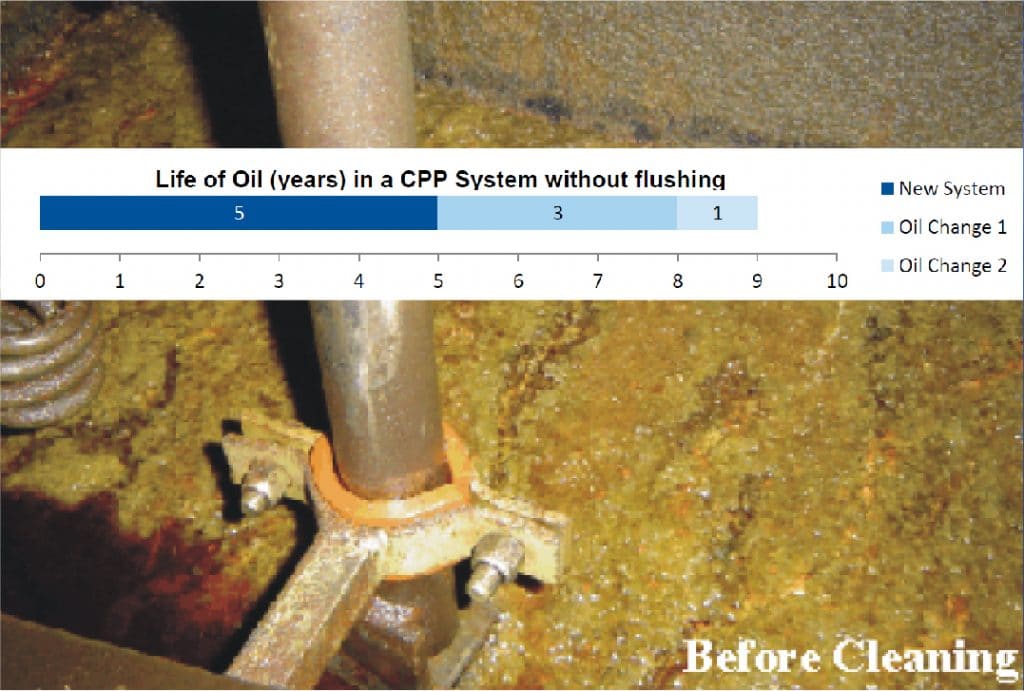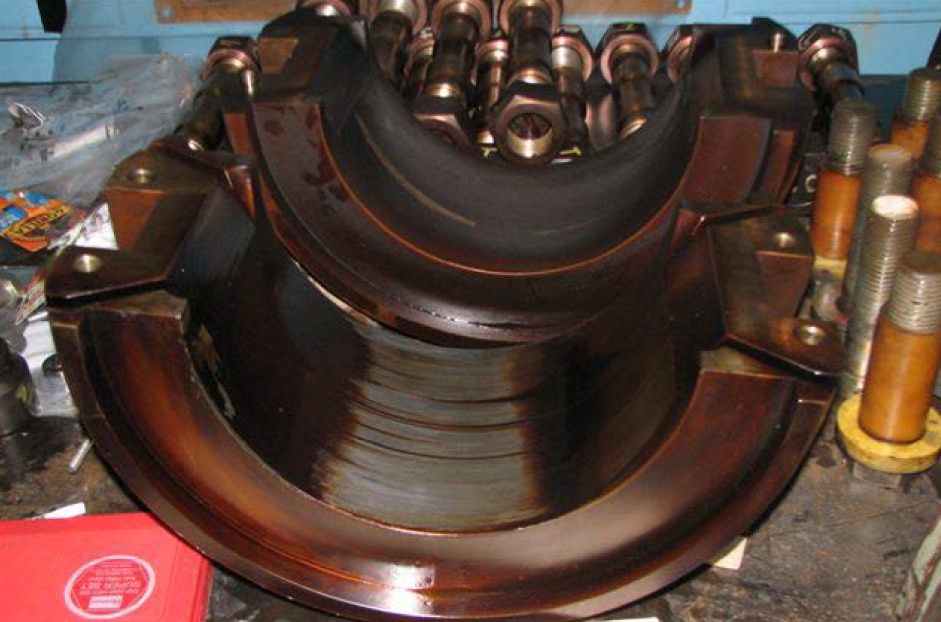Turbine Oil Flushing, Do We Really Need It?
What is flushing?
Within the industry, we’ve always heard that “flushing” should be done or there are particular conditions required to do a flush but what exactly is a flush? Is there one standard definition? As per ASTM D6349 (Standard guide for Cleaning, Flushing and Purification of Steam, Gas and Hydroelectric Turbine Lubrication Systems), flushing is defined as, “circulation of liquid through the lubrication system or a component, when the turbine is not operating to remove contaminant”. While this may constitute the standardized definition of a turbine flush, we’ve realized that within the industry, a flush can mean many different things. Typically, these are categorized into Mechanical, Chemical or Solubility Enhanced System Cleaning.
Types of Flushes
As discussed above, there are three main categories into which the types of flushes can be categorized. Each method has significant advantages, disadvantages and unique characteristics which define them. Let’s explore each type of flush and what differentiates them from the others.
Mechanical Flushes
These usually require external pumps where heated oil is pumped at a high velocity through the system. However, bearing jumpers are typically installed to increase bearing supply and return flow rates in addition to protecting the bearing surfaces from abrasive contaminants. System headers and valve blocks are also isolated from the flush, thus there is a need to perform mechanical cleaning of components after the flush has been performed.
Here’s a brief summary of some of the defining characteristics of a mechanical flush:
- Benefits – can remove large chunks of debris or broken components.
- Limitations – may not remove all of the degradation products (particularly sludge, varnish and other organic deposits).
- Risks – an experienced crew and specialized equipment is required. It can be disruptive to the system and may cause damage to old or sensitive piping. There is also the danger of spills should leaks be formed.
Chemical Flushes
Typically, for chemical flushes an oil soluble solution composed of naphthenic base with detergents, dispersants and corrosion inhibitors is added to the in service turbine oil, sometimes water based fluids with cleaners are used as well. The treat rate is approximately 10% used at 48 hours before the outage. Supplemental filtration is required during the flush to accommodate the increased volume of contamination released. After the in-service oil and cleaner are drained from the system, there must be a sacrificial flush to rinse the remaining cleaner from the system. Quite often, multiple charges of the flushing oil may be used to dilute the cleaner in the system and minimize the impact on the new oil.
Here are some of the defining characteristics of a chemical flush:
- Benefits – can suspend and dissolve degradation products from system internals.
- Limitations – may not remove broken components or large debris.
- Risks – the cleaner may not be compatible with the new turbine oil. Since residual cleaner may remain in the system, this can cause a significant impact on the water to air separation property of the oil and impact seal performance. This method is highly discouraged for steam turbines or systems prone to water contamination.
Solubility Enhanced System Cleaning
A solubility enhancer when added to an in-service oil can re-adsorb system deposits such as sludge or varnish. Typically, these solubility enhancers such as Boost VR+™ and DECON™ (both with Solvancer® patent pending technology) are added to the lube oil system at least 3 months prior to an outage in addition to a filtration system such as Fluitec’s ESP™ system which can remove the dissolved degradation products from the oil. Since the solubility enhancer is compatible with the turbine oil there is no need for a sacrificial rinse.
Let’s look at some of the defining characteristics of a solubility enhanced system cleaning:
- Benefits – sacrificial rinse is not required as the solubility enhancer is compatible with the turbine oil. Significantly fewer human and financial resources are required.
- Limitations – may not remove broken components or large debris.
- Risks – if an insufficiently amount of solubility enhancer is used or the residence time is too short then it can be rendered less effective.
Now that we’re more familiar with the types of flushes, let’s get into why and when they should be used.
Why should a flush be used?
Before we answer “when”, we need to understand why a flush should be used in the first place. Within the industry, it has become the common practice to drain sumps and then refill these with new charges of oil. We can think about this similar to having a full glass of red soda. When we have consumed this glass of soda (or drained the sump) there are usually remnants in the glass. If we added water to this glass without washing it, the water would now have a red soda flavour. In essence, we have contaminated the pure water with red soda similar to when we drain a sump (containing impurities) and fill this with new oil. The new oil will in turn become contaminated before being in-service which fundamentally decreases the life of this oil.
Oil degradation products are very reactive species and if there are remnants of these after the sump has been drained, then they will attack the new charge of oil and rapidly deplete the antioxidants. With remnants of varnish and sludge in the system, these can negatively impact other properties of the oil such as acidity, water separability, foam inhibition and Membrane Patch Calorimetry.
We’ve seen an example of the oil service life in a large ship’s pitch propeller hydraulic fluid sump being decreased drastically. Usually, the R&O fluid lasted for five years but after the first drain and refill (without flushing the sump), the oil life was reduced to three years! Afterwards, the drain and refill was repeated (without the flush again) and this time the oil life reduced to one year!
When should a flush be used?
We have already covered the types of flushes and the reasons for flushing but we have not yet covered when a flush should be used. Flushing is usually performed in any of the following circumstances:
- Commissioning of new machines
- Re-commissioning of machines that have been our of use for some time
- After a system component fails (which may leave debris in the system)
- When a filter collapses or goes into by-pass
- Once an incompatible fluid / contaminant has entered the system
- When switching brands of oil where the compatibility is not understood fully
- After the lubricant base oil health has degraded significantly
While these are the usual circumstances when a flush should be used there are also instances where a flush should be performed between oil changes. Here are a couple of guidelines on when flushing should be done between oil changes:
- There are indications that sludge, varnish or other deposits may be in the system
- The current in-service oil is in poor condition and there should be no remnants in the system to contaminate the incoming oil
- The new charge of oil is a different formulation from the in-service oil and there may be compatibility issues
Although the situations above may induce the reader to perform a flush between every oil change, there are times when no flush is required between oil changes. Here are those instances that do not require a flush between oil changes:
- The lubricant system is free of sludge, varnish or other deposits
- The majority of the old oil can be removed from the system
- The new turbine oil is the same type and brand as the in-service oil and there are no issues with compatibility (where ASTM D7155 have been done to confirm compatibility)
In essence, there are many times that we do need a turbine flush but we must be careful in selecting the type of flush that is ideally suited for our system and its conditions. Every system is different and would require analysis of the budget, time and resources available before an informed decision is made on the type of flush and when to flush the equipment.




